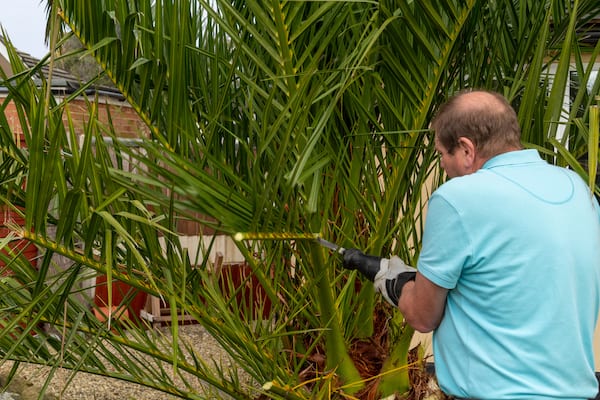Understanding the Importance of Pruning for Areca Palms
Pruning is an essential part of maintaining the health and appearance of Areca Palms. By removing dead or damaged fronds, trimming back overgrown stems, and shaping the palm, you can promote healthy growth, prevent pest and disease issues, and maintain a visually appealing shape. Areca Palms are popular ornamental plants, and pruning is crucial to keep them looking their best. Whether you’re a seasoned gardener or a beginner, learning how to prune Areca Palms is a valuable skill that can help you keep your plants thriving.
One of the primary benefits of pruning Areca Palms is the prevention of pest and disease issues. By removing dead or damaged fronds, you can prevent the spread of disease and reduce the risk of pest infestations. Regular pruning can also help to promote healthy growth by allowing more sunlight to reach the plant’s leaves and encouraging the development of new growth. Additionally, pruning can help to maintain the shape of the palm, keeping it looking neat and tidy.
Pruning can also help to improve the overall appearance of your Areca Palm. By removing dead or damaged fronds, you can create a more visually appealing shape and promote a fuller, more lush appearance. This can be especially important if you’re growing Areca Palms in a decorative pot or planter, as a well-pruned palm can add a touch of elegance to any room.
When it comes to pruning Areca Palms, it’s essential to use the right techniques and tools. Using sharp, clean pruning tools can help to prevent the spread of disease and reduce the risk of damage to the plant. It’s also important to prune at the right time, as pruning at the wrong time can cause stress to the plant and reduce its ability to grow and thrive.
By understanding the importance of pruning for Areca Palms, you can take the first step towards keeping your plants healthy and thriving. Whether you’re looking to promote healthy growth, prevent pest and disease issues, or simply maintain a visually appealing shape, pruning is an essential part of Areca Palm care. In the next section, we’ll explore the best time to prune your Areca Palm, including the optimal seasons and growth stages for pruning.
When to Prune Your Areca Palm: Timing is Everything
Pruning your Areca Palm at the right time is crucial to ensure the health and well-being of the plant. The best time to prune Areca Palms depends on the season and the growth stage of the plant. In general, it’s best to prune Areca Palms during the spring and summer months when the plant is actively growing. This allows the plant to quickly recover from pruning and reduces the risk of disease and pest issues.
During the spring, prune your Areca Palm to remove any dead or damaged fronds that may have accumulated over the winter months. This will help to promote healthy growth and prevent the spread of disease. In the summer, prune your Areca Palm to maintain its shape and promote fruiting. Remove any overgrown stems or fronds that may be blocking sunlight or water from reaching the rest of the plant.
It’s also important to prune your Areca Palm at the right growth stage. Prune your palm when it’s actively growing, but avoid pruning during periods of stress or drought. Pruning during these times can cause further stress to the plant and reduce its ability to grow and thrive.
So, how do you know when your Areca Palm needs pruning? Here are a few signs to look out for:
Dead or damaged fronds: If you notice any dead or damaged fronds on your Areca Palm, it’s time to prune. Remove the affected fronds to prevent the spread of disease and promote healthy growth.
Overgrown stems: If the stems of your Areca Palm are becoming overgrown or leggy, it’s time to prune. Cut back the stems to maintain the shape of the plant and promote fruiting.
Reduced growth: If you notice that your Areca Palm is not growing as quickly as it should be, it may be time to prune. Prune the plant to promote healthy growth and encourage fruiting.
By pruning your Areca Palm at the right time and growth stage, you can help to promote healthy growth, prevent pest and disease issues, and maintain a visually appealing shape. In the next section, we’ll explore the necessary tools for pruning Areca Palms, including pruning saws, loppers, and gloves.
Gathering the Right Tools for the Job: Pruning Essentials
When it comes to pruning your Areca Palm, having the right tools for the job is essential. The right tools can make the pruning process easier, safer, and more effective. In this section, we’ll discuss the necessary tools for pruning Areca Palms, including pruning saws, loppers, and gloves.
Pruning Saws: A good pruning saw is essential for cutting through thick stems and branches. Look for a saw with a curved or angled blade, as this will make it easier to reach into tight spaces and cut at an angle. A pruning saw with a comfortable grip and a sharp blade is ideal for pruning Areca Palms.
Loppers: Loppers are long-handled pruning shears that are perfect for cutting through thicker stems and branches. They are ideal for pruning Areca Palms that are too tall to reach with a pruning saw. Look for loppers with a comfortable grip and a sharp blade.
Gloves: Pruning gloves are essential for protecting your hands from thorns, splinters, and other sharp objects. Look for gloves that are made from a durable material, such as leather or synthetic materials, and have a good grip to prevent dropping tools.
Other Tools: In addition to pruning saws, loppers, and gloves, you may also need other tools to prune your Areca Palm. These can include a pruning knife, pruning shears, and a ladder or step stool.
Recommendations for the Best Tools: When it comes to choosing the best tools for pruning your Areca Palm, there are several options to consider. Some popular brands include Fiskars, Corona, and Felco. Look for tools that are made from high-quality materials, have a comfortable grip, and are easy to use.
Maintenance of Tools: To keep your pruning tools in good condition, it’s essential to maintain them regularly. This can include cleaning and sharpening the blades, oiling the hinges, and storing the tools in a dry place.
By having the right tools for the job, you can make the pruning process easier, safer, and more effective. In the next section, we’ll provide a step-by-step guide on how to prune your Areca Palm, including how to remove dead or damaged fronds, trim back overgrown stems, and shape the palm for optimal growth.
Step-by-Step Pruning Guide: A Beginner’s Tutorial
Pruning your Areca Palm can seem intimidating, but with the right techniques and tools, it’s a straightforward process. In this section, we’ll provide a step-by-step guide on how to prune your Areca Palm, including how to remove dead or damaged fronds, trim back overgrown stems, and shape the palm for optimal growth.
Step 1: Remove Dead or Damaged Fronds
Start by removing any dead or damaged fronds from your Areca Palm. Use a pruning saw or loppers to cut the fronds at the base, making sure to leave a small portion of the stem intact. This will help the palm to heal quickly and prevent the spread of disease.
Step 2: Trim Back Overgrown Stems
Next, trim back any overgrown stems or branches that are blocking sunlight or water from reaching the rest of the plant. Use a pruning saw or loppers to cut the stems at a 45-degree angle, making sure to leave a small portion of the stem intact.
Step 3: Shape the Palm for Optimal Growth
Once you’ve removed any dead or damaged fronds and trimmed back overgrown stems, it’s time to shape the palm for optimal growth. Use a pruning saw or loppers to shape the palm into a desired shape, making sure to leave enough foliage to allow the palm to photosynthesize.
Step 4: Check for Pests and Diseases
Finally, check your Areca Palm for any signs of pests or diseases. Look for any unusual growth patterns, discoloration, or pests such as spider mites or mealybugs. If you notice any signs of pests or diseases, take action immediately to prevent the spread of disease.
By following these steps, you can prune your Areca Palm with confidence and help it to
Common Pruning Mistakes to Avoid: Tips from the Experts
Pruning your Areca Palm can be a delicate process, and making mistakes can have serious consequences for the health and appearance of your plant. In this section, we’ll highlight common pruning mistakes to avoid when pruning Areca Palms, including over-pruning, under-pruning, and pruning at the wrong time.
Over-Pruning: One of the most common pruning mistakes is over-pruning. This can cause stress to the plant, leading to disease and pest issues. To avoid over-pruning, only remove what is necessary to maintain the shape and health of the plant.
Under-Pruning: Under-pruning is another common mistake that can lead to a lack of growth and a decrease in the plant’s overall health. To avoid under-pruning, make sure to remove any dead or damaged fronds and trim back overgrown stems.
Pruning at the Wrong Time: Pruning at the wrong time can also cause stress to the plant. To avoid this, prune your Areca Palm during the spring and summer months when the plant is actively growing.
Expert Advice: To avoid common pruning mistakes, it’s essential to have a good understanding of the plant’s growth habits and needs. Here are some expert tips to keep in mind:
Always prune with a purpose, whether it’s to maintain shape, promote healthy growth, or remove dead or damaged fronds.
Use the right tools for the job, including pruning saws, loppers, and gloves.
Make clean cuts, and avoid tearing or ripping the plant’s tissue.
Monitor your plant’s response to pruning, and adjust your techniques accordingly.
By avoiding common pruning mistakes, you can help to promote healthy growth, prevent pest and disease issues, and maintain a visually appealing shape. In the next section, we’ll discuss the role of pruning in managing pests and diseases that affect Areca Palms.
Pruning for Pest Control: Managing Pests and Diseases
Pruning is an essential part of managing pests and diseases that affect Areca Palms. By removing infested or diseased fronds, you can help to prevent the spread of disease and reduce the risk of pest infestations. In this section, we’ll discuss the role of pruning in managing pests and diseases that affect Areca Palms.
Identifying Infested or Diseased Fronds
Before you can prune for pest control, you need to be able to identify infested or diseased fronds. Look for signs of pests such as spider mites, mealybugs, or scale, and diseases such as fungal infections or bacterial leaf spot. Remove any fronds that show signs of infestation or disease.
Removing Infested or Diseased Fronds
Once you’ve identified infested or diseased fronds, it’s time to remove them. Use a pruning saw or loppers to cut the fronds at the base, making sure to leave a small portion of the stem intact. This will help the palm to heal quickly and prevent the spread of disease.
Pruning for Pest Prevention
Pruning can also help to prevent pest infestations. By removing dead or damaged fronds, you can reduce the risk of pests such as spider mites or mealybugs. Regular pruning can also help to promote healthy growth, which can make the palm more resistant to pests and diseases.
Expert Advice
To get the most out of pruning for pest control, it’s essential to have a good understanding of the plant’s growth habits and needs. Here are some expert tips to keep in mind:
Always prune with a purpose, whether it’s to remove infested or diseased fronds or to promote healthy growth.
Use the right tools for the job, including pruning saws, loppers, and gloves.
Make clean cuts, and avoid tearing or ripping the plant’s tissue.
Monitor your plant’s response to pruning, and adjust your techniques accordingly.
By pruning for pest control, you can help to prevent the spread of disease and reduce the risk of pest infestations. In the next section, we’ll discuss how to care for your Areca Palm after pruning, including how to water, fertilize, and monitor for signs of stress or disease.
Post-Pruning Care: How to Help Your Areca Palm Recover
After pruning your Areca Palm, it’s essential to provide the right care to help it recover. In this section, we’ll discuss how to care for your Areca Palm after pruning, including how to water, fertilize, and monitor for signs of stress or disease.
Watering: After pruning, it’s essential to water your Areca Palm thoroughly to help it recover. Make sure the soil is moist but not waterlogged, as this can cause root rot and other problems.
Fertilizing: Fertilizing your Areca Palm after pruning can help promote healthy growth and recovery. Use a balanced fertilizer that is high in phosphorus to promote root growth and development.
Monitoring for Signs of Stress or Disease: After pruning, it’s essential to monitor your Areca Palm for signs of stress or disease. Look for signs of pests, diseases, or nutrient deficiencies, and take action immediately if you notice any problems.
Providing Support: If you’ve pruned your Areca Palm heavily, it may need support to prevent it from toppling over. Use stakes or other supports to keep the palm upright and stable.
Expert Advice: To get the most out of post-pruning care, it’s essential to have a good understanding of the plant’s growth habits and needs. Here are some expert tips to keep in mind:
Always water your Areca Palm thoroughly after pruning to help it recover.
Use a balanced fertilizer that is high in phosphorus to promote root growth and development.
Monitor your Areca Palm regularly for signs of stress or disease, and take action immediately if you notice any problems.
Provide support for your Areca Palm if it needs it, using stakes or other supports to keep it upright and stable.
By following these tips, you can help your Areca Palm recover from pruning and promote healthy growth and development. In the next section, we’ll discuss advanced pruning techniques for shaping and training Areca Palms.
Advanced Pruning Techniques: Shaping and Training Your Areca Palm
For experienced gardeners and Areca Palm enthusiasts, advanced pruning techniques can help shape and train the palm to achieve a desired appearance or promote fruiting. One technique is to create a central leader by removing lower fronds and stems, allowing the palm to grow taller and more slender. This method is ideal for indoor containers or small gardens where space is limited.
Another technique is to prune the palm to maintain a fuller, more rounded shape. This involves removing select fronds and stems to encourage branching and create a more balanced appearance. When pruning for shape, it’s essential to consider the palm’s natural growth pattern and prune accordingly to avoid damaging the plant.
For Areca Palms grown outdoors, pruning can be used to control growth and promote fruiting. By removing select fronds and stems, gardeners can encourage the palm to produce more flowers and fruit. However, this technique requires careful consideration, as over-pruning can reduce fruit production and harm the plant.
When using advanced pruning techniques, it’s crucial to remember the importance of timing. Pruning during the wrong season or at the wrong growth stage can cause stress to the plant and reduce its ability to thrive. Gardeners should always prune their Areca Palm during the active growing season, typically in the spring or summer, and avoid pruning during periods of drought or extreme weather.
Additionally, gardeners should be aware of the potential risks associated with advanced pruning techniques. Over-pruning or pruning at the wrong time can lead to pest and disease issues, as well as reduce the plant’s overall health. To minimize these risks, gardeners should always use clean, sharp pruning tools and make precise cuts to avoid damaging the plant.
By mastering advanced pruning techniques, gardeners can take their Areca Palm care to the next level and achieve a more desired shape, promote fruiting, and maintain optimal health. However, it’s essential to remember that pruning is an art that requires patience, practice, and attention to detail. With the right techniques and timing, gardeners can unlock the full potential of their Areca Palm and enjoy its beauty for years to come.








